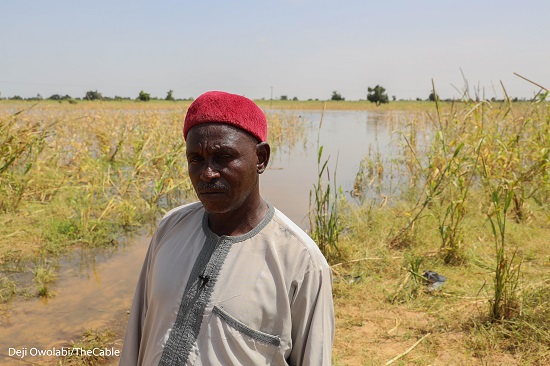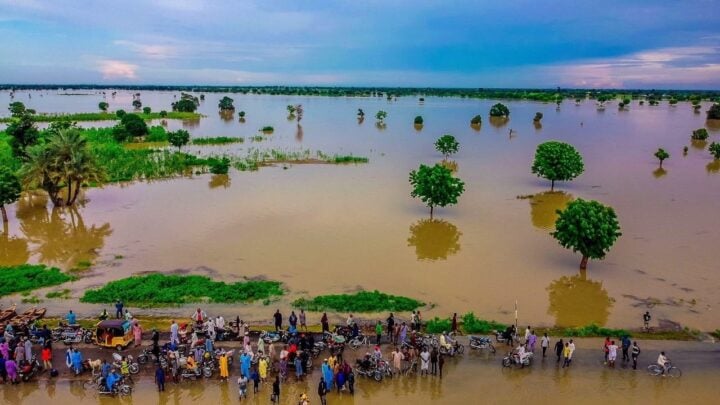File photo of flooding in Jigawa
In the wake of the devastating floods that swept through homes, livelihoods, and hopes of many Nigerians in 2022 and 2024, the need for sustainable solutions to climate-related disasters has never been clearer.
As Nigerians struggled to rebuild after the floods, insurance has emerged as a powerful, yet often overlooked, opportunity to shield the public from the escalating impacts of climate change — providing both immediate relief and long-term resilience.
The global impact of climate change is far-reaching, from wildfires to hurricanes and drought. In Nigeria, the case has never been different, as the country is often faced with conditions like rising sea levels, flooding, pollution, and desertification.
Insurance is a powerful risk management tool that can help cushion the impacts of climate change by transferring the financial burden of environmental disasters from individuals, businesses, and even governments to insurers.
Advertisement
It provides a safety net and financial buffer to facilitate quicker recovery and reduce long-term economic strain.
In 2022, the federal government said about 655 persons were killed, 356,086 houses and 676,945 farmlands were destroyed due to the devastating flooding that occurred.
Similarly, in 2024, the National Emergency Management Agency (NEMA) said flooding claimed the lives of about 320 persons, with 119,690 houses and 194,637 farmlands ravaged.
Advertisement
This data shows the stark reality of climate impact on vulnerable communities, as coastal states like Lagos with its housing deficit crisis have also felt the blow of coastal erosions.
The agricultural sector, one of the most vulnerable to climate change, saw prolonged drought, erratic rainfall patterns, and floods threatening crop yield in the past couple of years, causing insecurity and loss of income for farmers.
Other sectors like tourism and transportation have also witnessed their fair share of rising sea levels and coastal erosion.
CLIMATE INSURANCE AS A RISK MITIGATION TOOL
Advertisement

In 2024, when TheCable visited Taraba state, north-eastern Nigeria, to document the plight of tomato farmers in the thick of the scarcity of the staple food, it observed firsthand how prolonged heat waves, drought, and lack of early weather predictions, among other factors, have driven farmers into debt and loss of crop yield.
While the situation exposes the challenge of the low penetration rate of climate-related insurance in Nigeria, it also highlights the urgent need for farmers to insure their crops to protect them against weather-related crop failures.
Climate-related insurance is an insurance package designed to reduce the financial risks posed by climate change and extreme weather events.
These insurance products are becoming increasingly important in developing countries like Nigeria, where climate change is exacerbating extreme weather events and health risks.
Advertisement
By providing financial security, they help communities and businesses recover from the impacts of climate-related disruptions such as floods, droughts, heat waves, and disease outbreaks.
According to the National Bureau of Statistics (NBS), agriculture contributed 28.65 percent to Nigeria’s gross domestic product (GDP) in Q3 of 2024, making it the largest contributor to the country’s GDP.
Advertisement
In 2017, the Philippines, one of the world’s most vulnerable countries to climate disasters, established the first-of-its-kind risk insurance programme that provides 25 provinces with over $100 million in coverage against major typhoons by pooling risk and transferring it to private reinsurance markets.
Other countries like Kenya, Malawi, Zimbabwe, and Bangladesh have also put in efforts to integrate climate-related insurance into their policies.
Advertisement
The recent wildfires in Southern California, US, that claimed the lives of more than five people and destroyed over 1,000 houses have become an all-too-familiar reality of devastating impacts on communities and even wealthy nations.
The fire, fueled by extreme heat, prolonged droughts, and high wind conditions linked to climate change, highlights the crucial need for climate insurance, as the destruction is not just a temporary setback but a long-term challenge that requires robust recovery plans.
Advertisement
Back home in Nigeria, the Maiduguri floods, caused by both infrastructural and climatic change, also give credence to the need for the adoption of climate insurance.
CHALLENGES OF IMPLEMENTING CLIMATE INSURANCE
According to a 2019 report by the Nigerian Stock Exchange (NSE), the country’s insurance industry ranks 62nd in the world with $1.64 billion premiums representing 0.2 percent of premiums collected globally in 2018.
A 2022 survey by Augusto and Co. shows that the insurance penetration in Nigeria stood at 0.5 percent — one of the lowest and worst in Africa.
The lack of insurance awareness, especially in rural areas, is a significant barrier to expanding the reach and effectiveness of the service in many developing countries like Nigeria.
Also, a weak regulatory framework, lack of skilled personnel, and low standard of living have contributed to the low penetration of insurance in the country.
Accessing reliable long-term historical climate data is often an issue in African countries like Nigeria, as some areas have extensive datasets while others are poorly represented, making it difficult to generalise risks accurately on a global scale.
Given the vast amounts of data required for accurate modelling like satellite imagery, sensor data, and weather reports, the need for advanced technologies like artificial intelligence (AI) has become more important for climate insurers.
HOW CAN GOVERNMENT INCENTIVISE CLIMATE INSURANCE?
By implementing supportive policies and fostering Public-Private Partnerships (PPPs), governments can encourage individuals, businesses, and communities to adopt climate risk insurance
Through PPPs, the government can help bridge the gap between insurers and vulnerable communities, making insurance more accessible and affordable, by providing reinsurance (insuring the insurer) to reduce the financial risk of insurers, encouraging them to enter markets that might seem too risky.
Smallholder farmers and low-income communities are often the most affected by climate disasters and also the least able to afford insurance. The government can provide subsidies or financial support to help them access affordable insurance.
This can either be achieved through direct premium subsidies, tax incentives for insurers who cover these vulnerable sectors, or co-financing schemes that lower the cost of premiums.
To promote climate insurance, the government needs to promote index-based insurance packages, where payouts are determined by specific weather patterns like rainfall levels or temperature. This could help farmers benefit quicker.
For instance, in 2017, Heifer Nigeria, a non-governmental organisation (NGO), introduced a pay-at-harvest insurance programme for smallholder rice producers in Zamfara state, called the Pay-at-Harvest Area Yield Index Insurance.
The initiative provided smallholders with an affordable way to reduce their risk of crop loss from pests, diseases, floods, drought and other climate-related events.
The organisation also launched a finance leasing guarantee scheme to help farmers access innovative solar-powered irrigation pumps (SPIPs).
With initiatives like this and support from the government, Nigeria can leverage insurance to build resilience and adapt to the unending impacts of climate change in the country.
As atmospheric CO₂ levels and global temperatures continue to rise faster than ever, there will be a higher need for climate insurance. Hence, there is an urgency for the government to launch awareness campaigns to educate the public about its importance, especially in remote villages where people are unaware of how insurance works.
Add a comment











